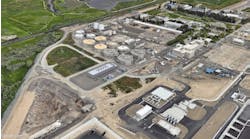Military Microgrids Move Ahead in Massachusetts and California…Veolia Finishes Boston Green Steam Project
Military microgrids advance at Otis AFB and MCAS Miramar
High ranking military and government officials were scheduled to gather today to see the latest plans for a military microgrid at the Otis Air National Base on Cape Cod, Massachusetts.
The leadership summit, held at the military base in Bourne, is a step in making the project a showcase and testbed where the Department of Defense and others can learn about microgrids, their economics and contribution to energy resilience and security.
The Otis microgrid will run largely on renewable energy. including solar and wind. It is being designed to ensure a high-level of grid security, according to a military news release.
“The resilient energy system project at Otis ANG Base is an excellent example of innovative airmen driving mission assurance through energy assurance. The 102nd Intelligence Wing has critical missions requiring uninterrupted access to electricity” said Miranda Ballentine, the assistant secretary of the Air Force for installations, environment and energy. “By integrating renewable energy, advanced energy storage, and innovative controls, this system will provide vital capabilities to our warfighters and intelligence professionals.”
Proposed by Raytheon, the Otis microgrid won a $6 million grant from the Defense Department’s Environmental Security Technology Certification Program.
The leadership summit was being hosted by the 102nd Intelligence Wing and was expected to drew several high-tech energy companies, along with Ballentine, Gen. L. Scott Rice, director of the Air National Guard; and state Rep. David Vieira of the 3rd Barnstable District.
The Otis microgrid is slated to start construction in 2017.
Meanwhile on the opposite coast, in California, progress continues on a microgrid for the Marine Corps Air Station Miramar. The base expects to complete the multi-phased project in 2019.
“With the installation of the microgrid, we have the potential to reduce or limit our dependency on the San Diego power grid,” said Col. Jason Woodworth, commanding officer of MCAS Miramar.
Download our free guide, “Reciprocating Engine Generators and Microgrids: The Last Defense Against a Power Outage.”
The Miramar microgrid, designed to use solar and landfill energy, will be able to keeping the flight line operational to support mission requirements should the base lose power.
“In the event of a grid outage, the military capabilities of operational forces aboard MCAS Miramar will remain intact,” said Michael McConnell, utilities planner for Marine Corps Installations West. “This will allow the air element of our nation’s defenses to be utilized at full strength.”
Mick Wasco, installation energy manager, says that the MCAS Miramar has the potential to have one of the most renewable and diverse microgrids in the Marine Corps, which ultimately will make MCAS Miramar better neighbors to the San Diego community.
“The San Diego region usually sees its highest electric usage in the summer when local residents are using a lot of air conditioning,” said McConnell. “During times like this, MCAS Miramar will be able to largely support its own electric needs and, therefore, lighten the burden on the already stressed out power grid.”
The Miramar microgrid is in the design phase.
Veolia completes Boston ‘Green Steam’ project
The Kendall Cogeneration Station has completed its Boston/Cambridge Green Steam project, a renovation designed to eliminate thermal pollution to the Charles River in Massachusetts.
The plant produces electricity and recycles thermal energy used to supply Veolia’s 20-mile steam distribution system in the Boston area.
Veolia, the plant operator, says that through its efficient CHP operations at Kendall Station, combined with a 7,000-foot steam pipeline extension completed in 2013, the company has doubled its transport of thermal energy, or Green Steam, to Cambridge and Boston metro customers via recovered heat.
By replacing the plant’s original once-through cooling system design with an air cooled condenser, Kendall Station now leverages ambient air for use in its thermal cycle, instead of Charles River water. This eliminates heated water discharge to the river, protecting the aquatic habitat.
“The success of Kendall Station is proof that energy production, environmental protection and economic prosperity need not be competing forces,” said Veronica Eady, director of Conservation Law Foundation Massachusetts. “This project offers a model that can be replicated around the nation — a blueprint for how to use, and even profit from, heated water from a plant rather than dumping it back into already-imperiled fish habitats.”
Track news about military microgrids — all microgrids for that matter — by following us on Twitter @MicrogridNews.






